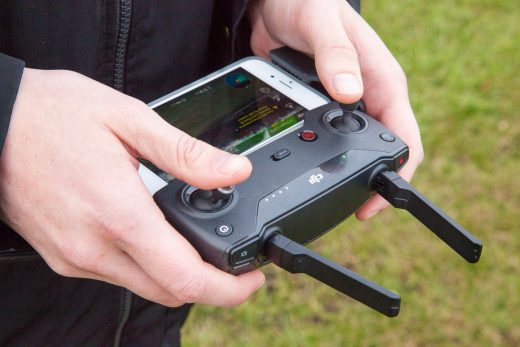The best drones for photos and video
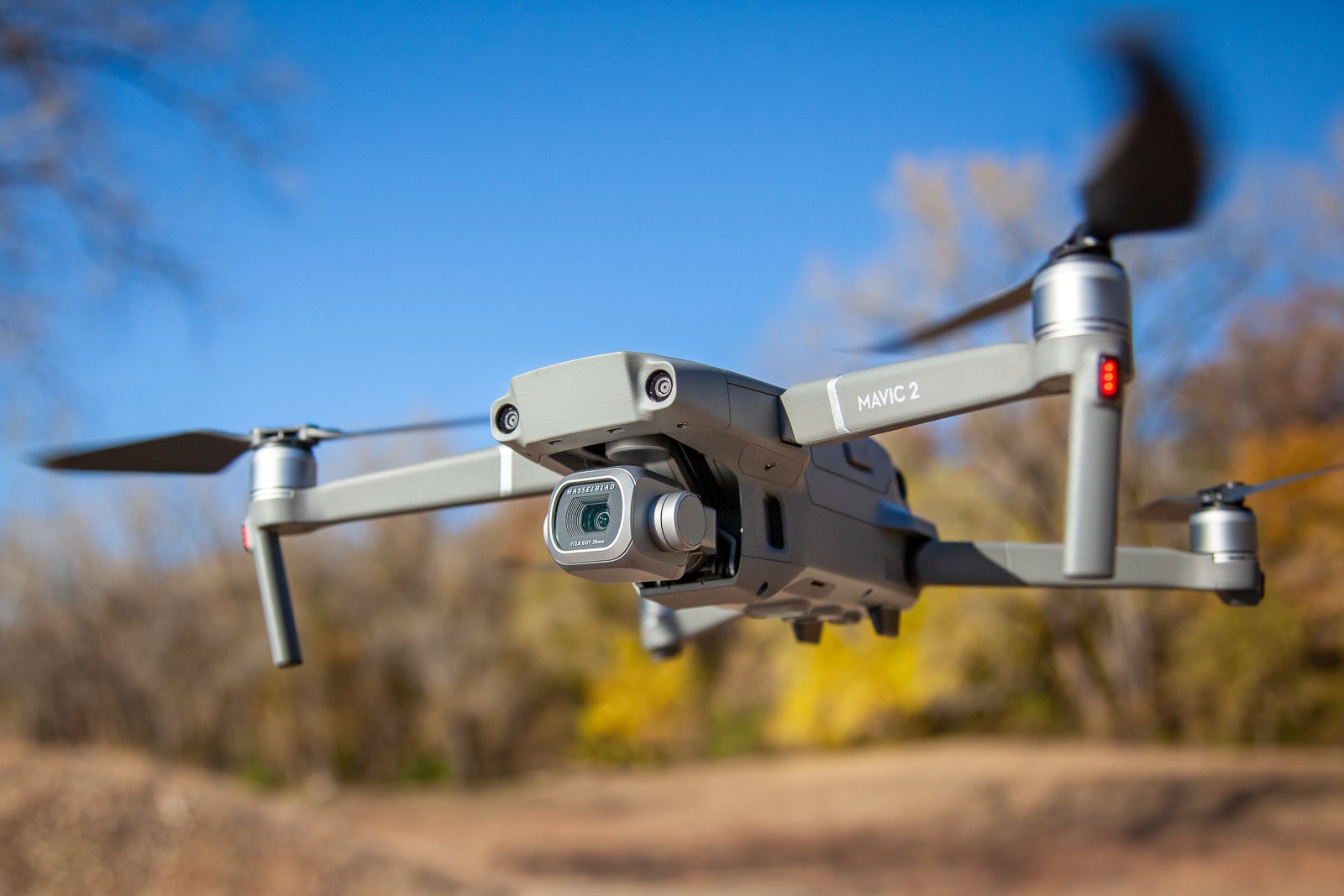
By Signe Brewster
This post was done in partnership with Wirecutter. When readers choose to buy Wirecutter’s independently chosen editorial picks, Wirecutter and Engadget may earn affiliate commission. Read the full drones guide here.
After 45 hours of research and test flying 14 models, we think the DJI Mavic 2 Pro is the best drone for aspiring aerial photographers and videographers thanks to its high-end camera, autonomous obstacle avoidance, long battery life, and portability. Pilots of all skill levels will find it to be exceptionally reliable and easy to fly.
The Mavic 2 Pro features a Hasselblad-branded camera (DJI bought a majority stake in the camera brand in 2017), which captures 20-megapixel photographs and 4K videos that look more colorful than those captured by the competition. Its ability to sense and avoid obstacles in all directions and steadily hold its position even in moderate winds lets you focus on your cinematography instead of worrying about keeping the drone steady.
It also features DJI’s smart-flight modes like ActiveTrack, which directs the drone to autonomously follow and film a subject while still avoiding obstacles. Its 31-minute battery life means you don’t have to land for a battery swap as often as other drones, and at 8.4 by 3.6 by 3.3 inches folded and 2 pounds, you can take the Mavic 2 Pro almost anywhere—it fits exceptionally well in our top pick for drone backpacks. It’s also compatible with the DJI Goggles FPV headset we recommend.
The Mavic 2 Zoom looks and flies identical to the Mavic 2 Pro, but it trades out the Hasselblad camera in favor of a different camera that can zoom 2 times optically and 2 times digitally (with software that avoids losing detail), for up to 4x usable “lossless” zoom. However, filming with more than 2x zoom will require you to shoot at 1080p instead of 4K. It’s a great choice for aerial photographers and videographers who need to work from a distance, whether they’re shooting a child’s soccer match or wildlife. Like our top pick, it features DJI’s obstacle avoidance and smart-flight mode tech, plus a 31-minute battery life and foldable body.
If you’re just getting into drone photography for personal use and social-media sharing, the DJI Spark is a less expensive model that still includes collision avoidance. Compared to our top pick, the Spark has shorter battery life and range, and it can’t capture 4K video (just 1080p), but it weighs half as much and folds up to about the size of your hand. It still includes the important features you need from a video drone, including image and flight stabilization and an included controller, and it has gesture controls and smart-flight modes like ActiveTrack.
Why you should trust us
A lifelong photography enthusiast, I have spent the past five years chronicling the rise of modern hobby drones by working closely with the industry’s professionals and hobbyists. I’ve studied photography-focused quadcopters and their smaller, more-agile cousins built for racing extensively. I have also spent hundreds of hours flying drones in all sorts of environments and write Wirecutter guides to drones under $100 and drone accessories.
Who this is for
Drones (or, more specifically, quadcopters) are small aircraft that can be equipped with a camera to give you the ability to shoot bird’s-eye-view photos and videos. They could be of interest to any photographer or videographer interested in reaching normally inaccessible spaces that would otherwise require a crane or helicopter, such as those high up in the air or across a body of water.
The drones covered in this guide might be of interest to certain professionals, including someone who wants to film a wedding, inspect gutters, or capture footage of a house going up for sale. But professionals shooting a film might want to look at higher-end options that allow you to mount your own camera equipment on the drone. There are also specialized options for people who want to inspect farmland and industrial equipment, which can call for specialized sensors. We did not test drones that are only focused on autonomously following and filming a moving subject (such as the Skydio R1) because they do not let videographers frame their own shots.
Thanks to improvements in technology and rapidly declining prices, you can get a decent photography drone for as little as $400. But if you’re looking for your first drone and want to get used to flying before risking even that much, we have a guide to inexpensive models (without nice cameras) that are great for learning.
Regardless of which drone you choose, know that there’s an evolving body of regulations surrounding drone flight and appropriate usage that you should get familiar with before buying and flying.
How we picked and tested
After reading professional and user reviews plus speaking to enthusiasts, experts, and manufacturers at the 2018 CES conference, we decided to consider the following criteria while looking for drones to test:
- A quadcopter design: Drones shaped like planes do exist, but they’re not as easy to fly as quadcopter models shaped like an X. A quadcopter shape (or alternatives like hexacopters that add additional arms) make for the most stable photo and video because they can hold their position in the air steadily.
- Crash-avoidance sensors: Sensors in drones have come a long way, and there are now some models that can sense obstacles approaching in any direction and adjust their flight path to avoid a crash. This removes so much stress from flying that we are only willing to consider drones that at the very least can sense obstacles approaching from their front, back, and bottom.
- A high-quality camera: Generally, the more you pay for a photography drone, the better quality camera you get. For our top pick, we only considered models that can shoot at least 12-megapixel photos and 4K video. We were willing to consider less impressive specs for our budget pick.
- A three-axis gimbal: A good gimbal, which stabilizes a camera attached to a drone with accelerometers and gyroscopes even when you are flying in wind or a jerky pattern, is essential if you want usable footage. A three-axis gimbal is a general industry standard.
- Long battery life: Longer-lasting batteries tend to be larger and weigh more, so manufacturers have to balance drone size with battery life. But a shorter flight time means fewer shots, shorter videos, and less flexibility. We prefer drone batteries that last at least 20 minutes and recommend that pilots pick up a few extras so they can spend more time in the field flying.
- Autonomous modes: Any video drone worth buying should have a fail-safe return-home mode that automatically brings the aircraft back to the launch point when you press a button or the drone loses contact with the controller. Additionally, we prefer drones that come pre-programmed with cinematic autonomous flight modes; at the touch of a button, you can tell a drone to follow you while you snowboard down a mountain or fly in a circle while filming for a dramatic selfie.
- Portability: The best drones are portable enough to be an everyday tool, which means they are small and light enough to pack into a camera bag or backpack. Some drones accomplish this by having foldable arms that make them more compact.
- Long flight range: Federal rules say you must always keep a drone within your line of sight. But in special cases, a drone’s ability to fly an especially long distance without losing contact with a controller can be a useful tool.
- Intuitive controller: Most drone controllers look similar, with two joysticks for controlling flight and a smattering of buttons for specific tasks. Controllers with a built-in screen or option for attaching a smartphone so you can gain additional abilities with an app extend their functions even further, often more intuitively.
Using these criteria, we were able to pare the 2016 testing field down to the DJI Mavic Pro, the DJI Phantom 3 Standard, the DJI Phantom 4 Pro, the Yuneec Typhoon H hexacopter, the GoPro Karma, and the Parrot Bebop 2. We tested the DJI Spark in 2017 and then the DJI Mavic Air and DJI Phantom 4 Pro v2 in early 2018. In late 2018, we tested the DJI Mavic 2 Pro, DJI Mavic 2 Zoom, and Autel Evo.
We shot photos and videos with each drone to evaluate camera quality, which also helped us gauge stabilization quality and see whether propellers appeared in any of the shots. We also tried all of the advertised intelligent flight modes and crash-avoidance systems by flying the drones through trees. We tested maneuverability and controller sensitivity by flying fast with lots of turns.
Our pick: DJI Mavic 2 Pro
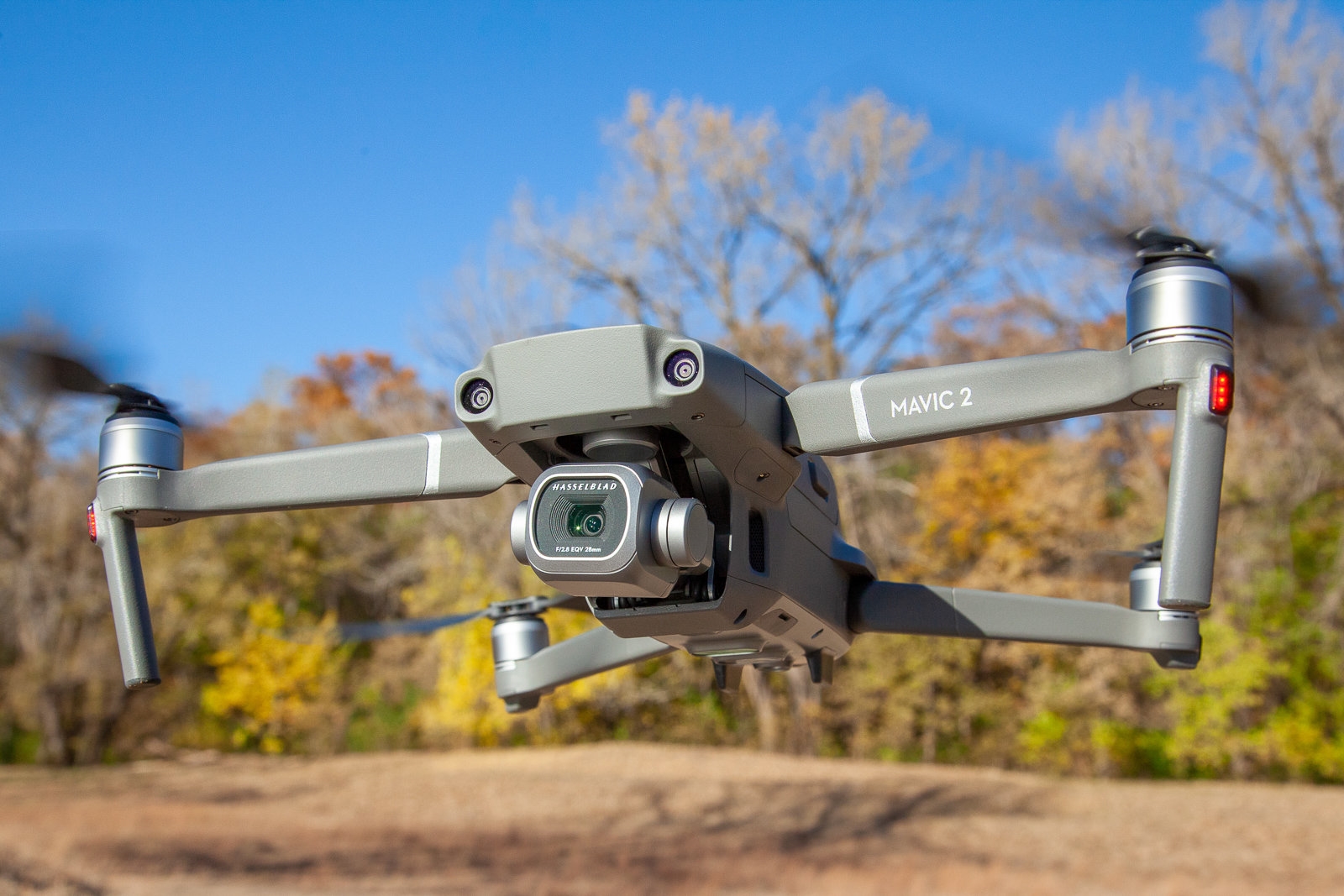
The DJI Mavic 2 Pro is the best drone for budding aerial photographers and videographers because of its ability to sense obstacles coming from any direction, the sharp, colorful photos and videos its camera shoots, and how easy it is to fly. Its three-axis gimbal provides effective image stabilization, and its 31-minute battery life means you have to land less often. The Mavic 2 Pro’s ability to autonomously return to its launch point and land itself and its pre-programmed flight modes let both beginners and advanced pilots get cinematic-looking shots without much effort.
In flight, the Mavic 2 Pro uses sensors to detect obstacles up to 65 feet away approaching from its sides, front, back, bottom, and top. Obstacle sensing removes stress from the flying experience, both manually and with any of DJI’s pre-programmed flight options. During testing, the Mavic 2 Pro stopped short when we tried to fly it at a tree, and it flew around a tree blocking its path when we directed it to autonomously return to its launch point. It beeped loudly to warn us whenever we flew close to an obstacle and automatically slowed its descent while landing so it gently set down on the ground every time. Note that the side sensors on the Mavic 2 Pro only work while you are flying in Tripod and ActiveTrack mode. If you ever do need to fly close to an obstacle for the perfect shot or a more sports-like performance, you can turn off obstacle sensing and avoidance.
The Mavic 2 Pro is the first drone in the Mavic line to sport a camera that competes with DJI’s previously higher-end Phantom drones. The 20-megapixel, 4K camera is branded by Hasselblad, a Swedish company known for medium-format cameras that DJI acquired in 2017. Considering the camera is as small as a fun-size candy bar, it’s impossible for it to capture the same quality as Hasselblad’s larger cameras. But DJI and Hasselblad did work together on a few features that are notable for a drone, including a 1-inch CMOS sensor that can be used in lower light conditions because it tops out at an ISO of 12,800.
The companies also say they adapted Hasselblad’s method for making colors look more realistic without having to finetune color settings and that the drone captures more colors than other DJI drones. We did find that the colors look truer and brighter than the Mavic 2 Zoom, which has a different camera and produced images that had a pinker hue. The Mavic 2 Pro shoots 4K video at up to 30 frames per second (which is weaker than the handful of drones like the Phantom 4 Pro v2 that shoot 60 fps) with a 100 Mbps max bitrate (the processing speed at which the camera is recording digital media). The aperture can be set anywhere between f/2.8 and f/11.
The Mavic 2 Pro is one of the most consistently stable drones we’ve ever flown. In our tests, it hovered accurately and resisted drifting, even when we flew in winds topping 20 miles per hour on a river bank. Like many drones, it uses a combination of GPS and GLONASS satellites, as well as the vision cameras, to monitor movement and altitude changes.
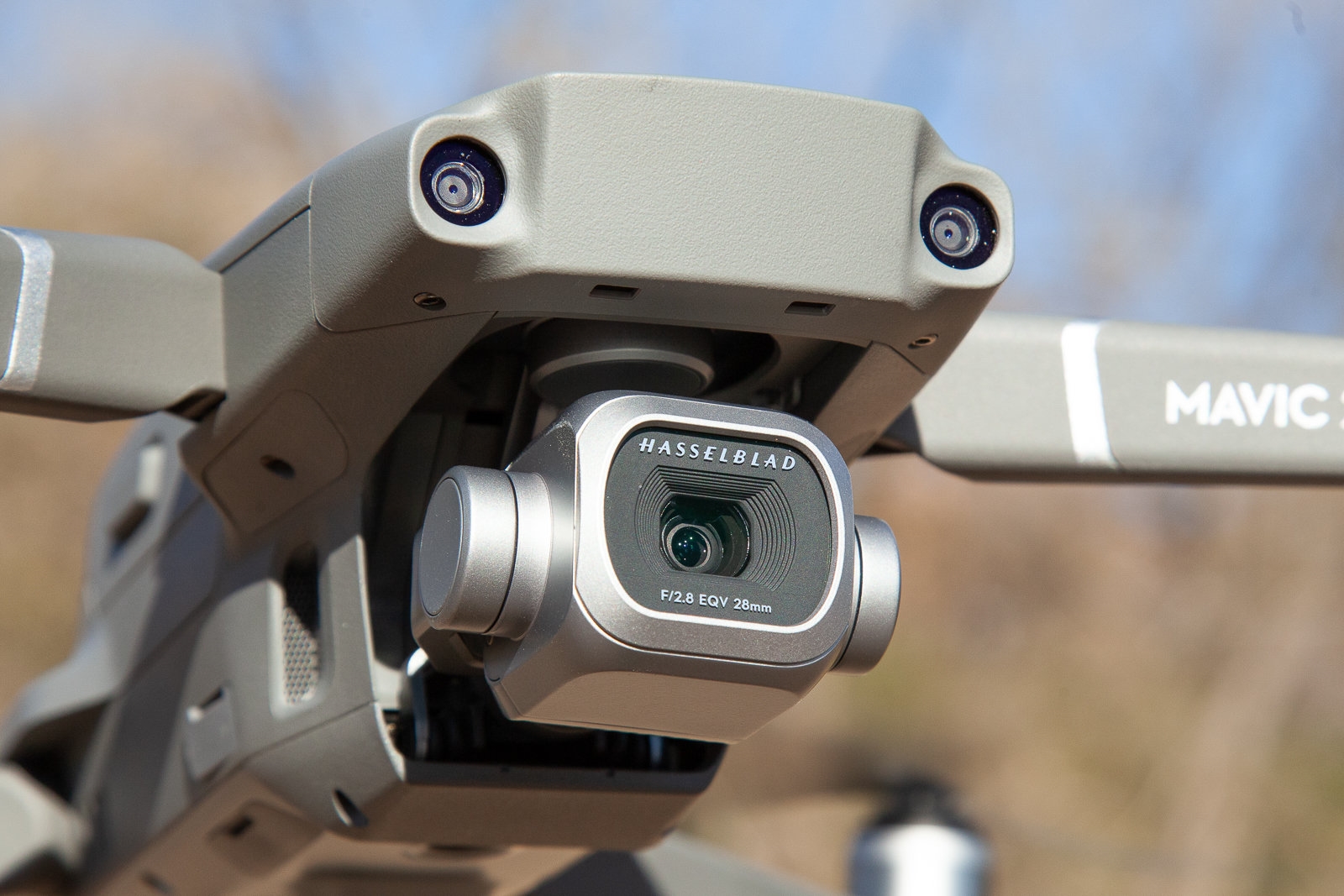
At up to 31 minutes, the Mavic 2 Pro’s battery life is impressive. It’s annoying to get into the rhythm of flying a drone and then get an alert just a few minutes later that it’s time to land and change the battery, which is our main problem with the drones we cover in our guide to inexpensive drones. Battery life should be one less thing to think about. The Phantom 4 Pro v2 and Mavic Pro Platinum have a similar 30 minutes of flight time. The more portable Mavic Air and Spark have 21 and 16 minutes of flight time, respectively.
Photographers and cinematographers can take their skills further with the pre-programmed flight modes. We most often used ActiveTrack, which directs the drone to follow a subject (or yourself). In QuickShots mode, the Mavic 2 Pro can autonomously film in elaborate cinematic ways such as circling around a subject or zooming away from it. Tripod Mode, which limits the drone’s speed to 3 mph and softens the controls to prevent jerky movement for cinematic shots, is also useful.
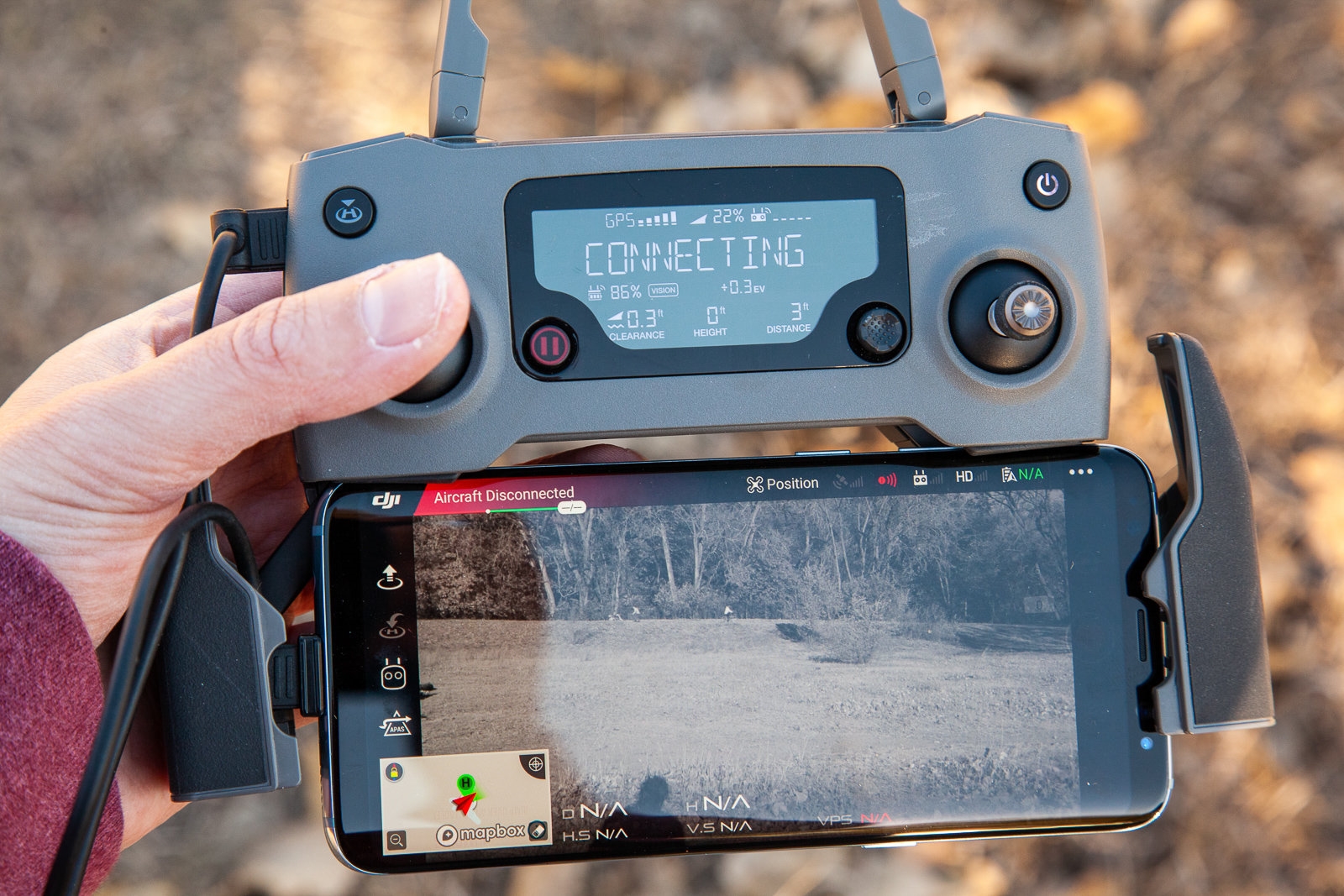
Despite its larger camera, the Mavic 2 Pro still folds up to 8.4 by 3.6 by 3.3 inches—about the size of a large coffee thermos. It weighs 2 pounds and doesn’t require any assembly before you fly (aside from removing the camera cover). The controller is the size of an eclair. Compared to Phantom drones, which generally require a dedicated backpack or case to carry, the Mavic 2 Pro is much more conveniently sized. You can stow it in a conventional camera bag or even a purse. Our budget pick, the Spark, is even smaller and lighter.
You can fly the Mavic 2 Pro up to 5 miles away, though US rules say you or a spotter must always have the drone within your line of sight. It uses DJI’s OccuSync 2.0 transmission system, which means it is wirelessly compatible with DJI Goggles—the first-person view headset we recommend if you want to see what the drone’s camera is seeing.
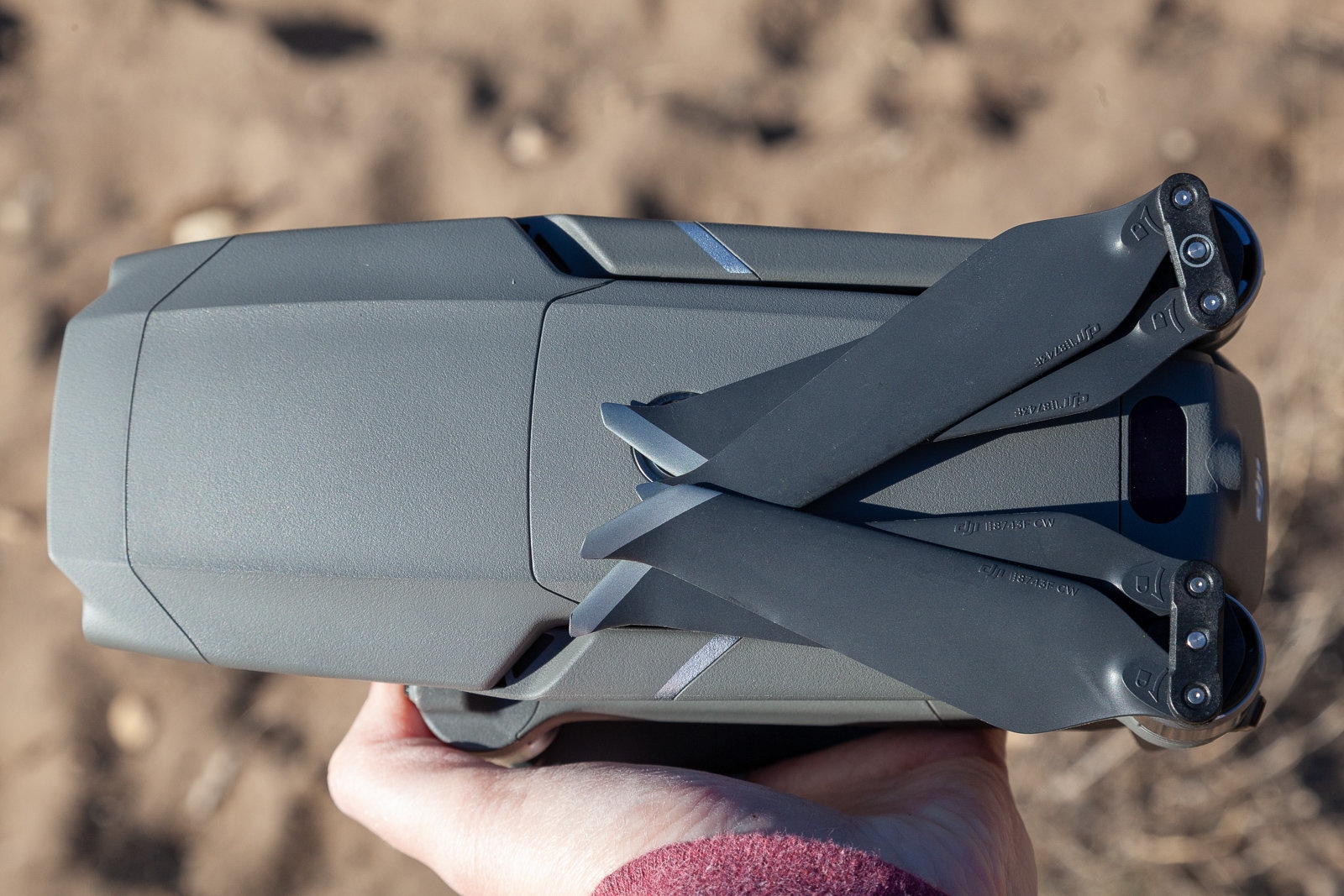
The Mavic 2 Pro’s wireless controller doesn’t have a secondary LCD like Phantom drones, but it does have a slot for a smartphone. You can use DJI’s Go 4 application for drone calibration, camera settings, GPS maps, and intelligent flight modes. Most importantly, it displays a 1080p live feed from the drone’s camera so you can frame shots to your liking. It also tracks all of your flight information (which you can replay if you’re trying to repeat a shot), warns you about any flight restrictions in the area, and has built-in video-editing tools. The smartphone connects to the controller via an included specialized USB Type-C, Micro-USB, or Lightning cable threaded through the side of the left brace—you can use a standard cable, but it sticks out oddly and limits motion.
While you can use the DJI app to control almost everything about the drone, you still need to use the controller to pilot it. We found the drone responded nimbly to our controls even while flying in the faster and more agile Sport mode. It was also easy to adjust the tilt of the drone’s camera with the wheel built into the controller or hit the specialized buttons that prompt the camera to take a picture or start filming.
Flaws but not dealbreakers
The Mavic 2 Pro may not be best for people with older smart devices, as it requires iOS 9.0 or later or Android 5.0 or later. Competitors such as the Yuneec Typhoon H, while not as easy to fly as the Mavic 2 Pro, use controllers with built-in touchscreen LCD panels for the live feed so you don’t need to supply your own iPhone (which also means one less thing to worry about charging). The Mavic 2 Pro’s controller is very compact, best suited for a phone rather than a tablet, and some people might find it is not as comfortable as the larger Phantom controller––the price you pay for portability.
We’ve also read a number of reports (and learned from Wirecutter senior editor Dan Frakes’s personal experience) that DJI’s customer service can be very slow, with especially long waits for repair service, though the company is quick to send replacement parts. Keep in mind that pilots who have encountered serious equipment damage in the past have experienced lengthy downtimes.
Also great: DJI Mavic 2 Zoom
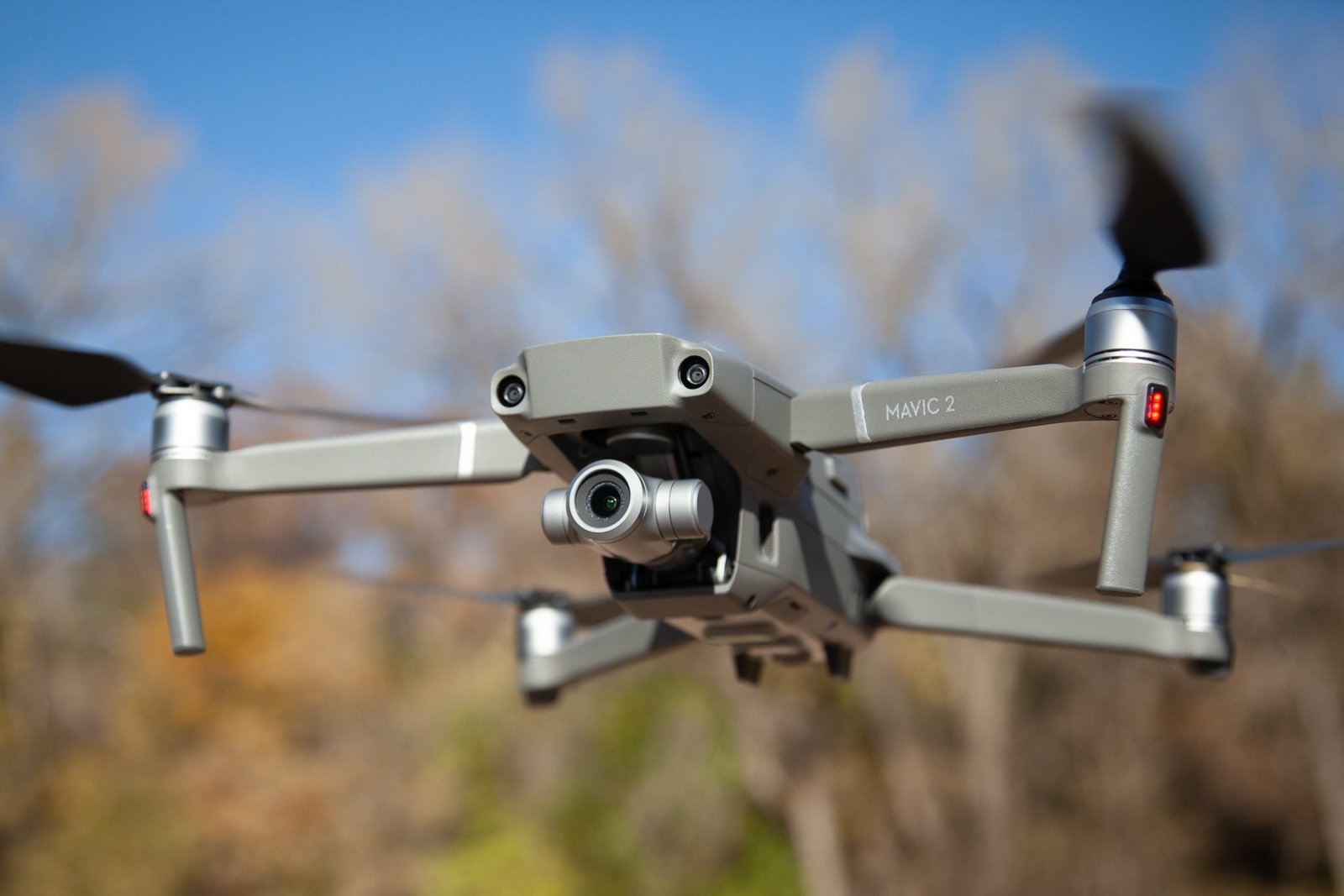
The DJI Mavic 2 Zoom could be a better option for photographers and videographers who care more about having a zoom lens than extra megapixels. By combining its 24-48mm telephoto lens with a digital zoom, the drone can shoot HD video with up to 4x lossless zoom. That’s useful if you’re photographing noise-sensitive wildlife or interested in achieving cinematic effects that use a zoom. Otherwise, you can just fly any drone toward a subject to achieve a zooming effect.
The drone has a 12-megapixel 4K camera and a 1/2.3-inch sensor, which is in line with older Mavic drones like the Mavic Air but not as good as the Mavic 2 Pro. It can film 4K video while zooming in up to 2x, but zooming further requires you to film at a max quality of 1080p. Its f/2.8 to f/3.8 aperture range is also more narrow. We felt the images and video it captured had more of a pinkish tinge and duller colors overall compared to the Mavic 2 Pro.
However, we used the telephoto lens to zoom in twice as far as we were able to with the Mavic 2 Pro. We photographed a flower conservatory and a bridge, two subjects that we felt uncomfortable filming from up close. We also used the Mavic 2 Zoom’s new Dolly Zoom effect, an autonomous flight mode where the drone flies away from a subject while zooming in on it, giving the impression the subject is standing in place while the background shifts. It’s a neat effect, as long as you don’t overuse it.
Other than the camera, the Mavic 2 Zoom looks and flies identical to the Mavic 2 Pro. It can detect and avoid approaching obstacles, uses batteries that last up to 31 minutes, and remains extremely stable while holding its position in the air. Along with Dolly Zoom, it comes with DJI’s other pre-programmed flight modes, and at 8.4 by 3.6 by 3.3 inches and 2 pounds, can be carried in the water-bottle pocket on some backpacks. You can fly it up to 5 miles away and view a 1080p preview on a phone screen thanks to DJI’s OccuSync 2.0 transmission system. It also uses the same controller as the Mavic 2 Pro.
An entry-level photography drone: DJI Spark
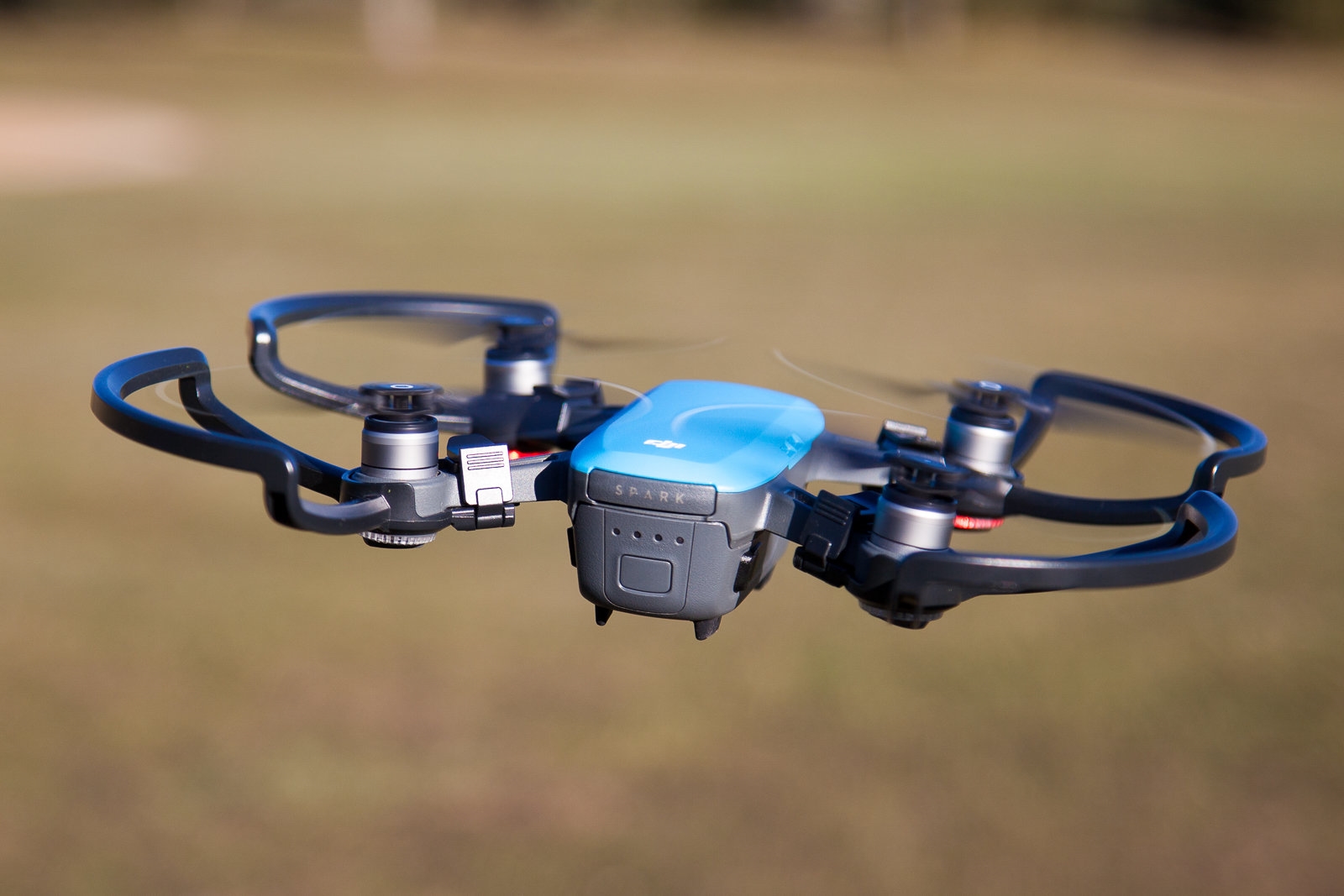
The DJI Spark is one of the most basic and inexpensive models DJI offers and is an ideal beginner drone. Though it lacks the 4K recording, advanced AI, and extended flight time and range of the Mavic 2 Pro, the Spark weighs and costs a third as much and still retains important beginner-friendly features. The drone can take off, land, and return to home with the push of a button. It also has an intelligent enough positioning system to hold its location in the air. For a beginner who isn’t yet ready to learn how to pilot a drone and just wants to start taking photos and videos, they can begin by controlling the Spark from a smartphone or even gesture controls.
The Spark has a good stabilization system for someone just starting to get into drone photography and videography. It offers speeds of up to 31 miles per hour as well as 16 minutes of flight time, about half of what’s available in higher-end drones like our other top picks. This is a drone that would be at home following a snowboarder down a hill but would be passed over by professionals who need a better camera.
The Spark packs a 12-megapixel camera that can record 1080p video, which is quite a bit below the 4K capabilities of the Mavic 2 Pro and Zoom. It’s high enough quality to post a decent video to Instagram but not good enough to produce professional-looking results. The camera is mounted on a two-axis gimbal (compared with the Mavic Pro and Phantom 3 SE’s three-axis), which is enough to capture jitter-free videos but produces more horizontal shake. However, two-axis gimbals are lighter and contribute to the Spark’s portability and agility.
The DJI Spark’s autonomous features and intelligent flight modes help beginners feel more confident flying the drone because it can avoid obstacles, hold its position in the air, and return to home and land itself in an emergency. It has more intelligent flight modes than the Phantom 3 SE, but not as many advanced options as the Mavic 2 Pro or Zoom. It has QuickShot (film a subject with a preset flight pattern, such as ascending straight up or circling), TapFly (tap a point on the screen where you want the drone to fly), ActiveTrack (track and follow a subject), and a mode the other picks do not: Gesture (control the drone’s actions with your hands).
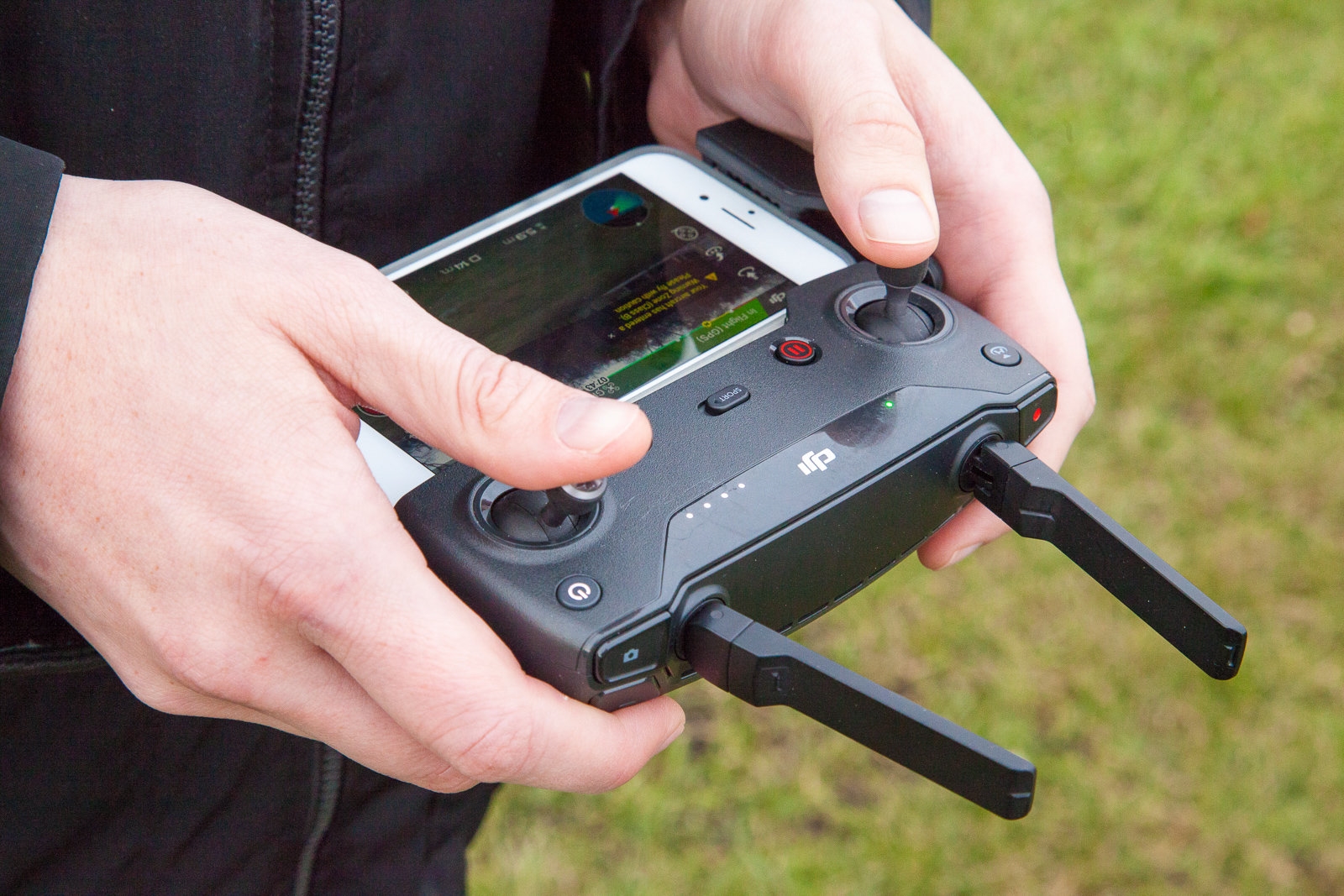
The drone relies on the DJI Go app for a live stream from the drone’s camera, access to many of the intelligent flight modes, and a second location for activating things like auto takeoff and landing. The app provides a 720p FPV live view on a smartphone or tablet, which works well at a range of up to 109 yards, but it lacks the video quality and reliability of the OcuSync system found on the Mavic 2 Pro and other higher-end models. If you need more range, you can buy a separate remote control to fly the Spark up to 1.24 miles away. The bundled version of the Spark comes with a lower-end but similar controller to the Mavic 2 Pro (minus the screen).
Alternatively, you can control the drone entirely with gestures. In theory, waving your arm in front of the drone tells it to follow you, and holding your arms up in a V shape causes it to fly to you. Holding your hand directly under the drone triggers it to land on your palm. This ability is promising for situations where you don’t want to be fiddling with a handheld controller. But in testing, we often had trouble getting the drone to recognize our gesture on the first try because it sometimes needed to be done at a precise distance and height. It’s a great idea with a lot of promise, but we’d like to see better reliability in future firmware updates.
How to safely fly a recreational drone
Anytime you set out to fly a drone, it’s important to ensure that you, the pilot, are doing everything safely and legally. While we can’t provide legal advice, we did speak to experts and consult Federal Aviation Administration and Academy of Model Aeronautics documentation to collect steps that we consider essential for every recreational pilot.
“The main thing to keep in mind is we’re sharing the airspace with manned full-size aircraft,” Academy of Model Aeronautics government affairs representative Tyler Dobbs says. “We’re not trying to push things to the limit and do things outside of AMA safety guidelines or the FAA rules. Just have fun but do so within one of the federal paths of operating legally and safely.”
Familiarize yourself with the AMA
Different types of drone pilots must abide by different rules and laws. Here we’re focusing on those who use drones for recreational purposes—what the FAA calls a “model aircraft.” That means they can’t sell the photos or videos they take with their drone or use the drone for any other business-related reasons.
Recreational drone users can either get a remote pilot certificate from the FAA, which requires an in-person test, or “follow community-based safety guidelines and fly within the programming of a nationwide community-based organization” (a much easier option). Commercial pilot and drone lawyer Jonathan Rupprecht says “this is the chief thing you need to pay very close attention to” and that it’s something people often misunderstand or miss. You do not need to join a nationwide organization, but you do need to follow their rules; a broadly accepted option is the Academy of Model Aeronautics. Here’s their handbook.
Get a registration number
Once you’ve committed to following the AMA’s rules, you need to register with the FAA. Visit their website and follow the checkout process, which is about 2 minutes long. You’ll need to submit your name, phone number, and address, and you’ll need to pay $5. Then the FAA will issue you a registration number valid for three years. It also generates a printable certificate, which could be useful if someone like a police officer ever questions you while you are flying.
Once you have a registration number, you need to label each drone you fly for the next three years with that number. Unlike a commercial pilot, recreational pilots do not need to complete a new registration for each drone they fly.
Know the rules
You should read both the FAA’s guidelines and AMA’s handbook (be prepared for them to contradict one another at times), but in general, these are the essential rules that apply nationally:
- Fly within line of sight. If you are wearing a first-person-view headset, you must have a spotter who can visually see the drone without aids such as binoculars.
- Drones must weigh less than 55 pounds unless certified by a community-based organization like the AMA.
- Do not fly near other aircraft.
- Do not fly within five miles of an airport. If you do, you must notify the airport and air traffic control tower prior to the flight. To check whether you are far enough away from an airport, you can use a tool such as the AMA Flying Sites Map or DJI’s mobile app.
- Do not fly near emergency response efforts.
- Do not fly while under the influence of drugs or alcohol.
Locally, there can be even more rules for drone flights. For example, It’s illegal to fly a drone in the US National Park System (unless there’s a designated area) or within an extended 15-mile range of Ronald Reagan Washington National Airport. Check your city and state’s specific rules governing drone flight.
Fly cautiously
Do everything you can to minimize the chances of something going wrong when you fly a drone for the first time. Read the manual and take the time to watch YouTube videos about safe setup and flight.
“People tend to crash these things unnecessarily because they can’t read the manual,” Rupprecht says. “The first flight and second flight you’re scared out of your mind. The third flight you hear the (sings theme song) Top Gun music and you say, ‘Yeah I can do it!’ You go outside and you’re flying and you crash it. Before being lawful, figure out how not to do that.”
It might be worth it to invest in a flight simulator to practice controls before your first real flying adventure. Otherwise, the best way to fly a drone for the first time is to learn from others. Chances are there is a drone club in your area. In my experience, they are welcoming to newcomers and members are happy to show you the basics.
“They will help you learn the rules, they’ll help you learn how to fly and show you that, yes, there’s things that you need to take seriously while you’re operating in the airspace, but overall it’s a great and enjoyable hobby,” Dobbs says.
Some other helpful tips:
- Pick flying sites with a generous amount of room, few obstacles, and few people.
- Do not fly in adverse weather.
- Have a plan for returning a drone to your location if something goes wrong.
- Fly within your current abilities.
There are a lot of rules governing drone flight, but it should still be about having fun. Take your time, learn new things, and don’t forget why you started flying in the first place.
The competition
The DJI Mavic 2 Enterprise has similar specs to the Mavic 2 Zoom plus a port to add optional accessories like a spotlight, speaker, and beacon. It’s built to be useful to firefighters, law enforcement, and search and rescue teams. As a result, we didn’t test it for this guide, as it is not meant for people primarily using a drone for photography.
The DJI Phantom 4 Pro+ V2.0, is equipped with OcuSync, which connects directly with DJI Goggles. Compared to previous Phantom models, it cuts the drone’s propeller noise in half. We flew the drone in mid-2018 and found it to be reliable, but aside from its included screen and ability to shoot 60 fps at 4K, we didn’t feel it offered enough additional benefits that topped the Mavic 2 Pro’s portability.
We had plans to make the DJI Mavic Air our top pick before the arrival of the Mavic 2 Pro, and we still think it’s a great drone. It’s essentially a hybrid of the Mavic 2 Pro and Spark; it’s smaller and lighter with gesture control abilities, but has the same smaller sensor as the Mavic 2 Zoom and a 21-minute battery life. It’s a good option if you are willing to spend a bit more to get something like the Spark with a better camera.
The Autel Evo is a fun and reliable drone we tested in late 2018. It reminded us a lot of the Mavic line: a foldable shape, steady position holding, and an easy-to-use app that includes pre-programmed cinematic modes. However, its 12-megapixel 4K camera and lack of a zoom lens meant it couldn’t quite compete with the Mavic 2 Pro or Zoom. (It can shoot 4K at up to 60 fps like the Phantom line.) It is a closer competitor to the Mavic Air, though it costs a bit more.
The Parrot Anafi packs in a lot at a low price. It sports a fold-up design and a 21-megapixel camera that shoots 4K HDR video on a 180-degree tilt gimbal. It has 25 minutes of battery life and can go up to 32 mph. We think obstacle avoidance is important enough that the Anafi’s lack of obstacle sensors disqualified it from us even testing it, but if you’re an experienced pilot on a budget who considers a high-quality camera more important than obstacle avoidance, it could be a better option than the Spark.
The Yuneec Typhoon H with Real Sense hexacopter looks like a promising update to the original Typhoon H thanks to its advanced obstacle avoidance. We wanted to test it, but Yuneec was unable to send us a drone for review. It shoots 12-megapixel photos and 4K videos, and it can fly for up to 25 minutes. We like the safety of a hexacopter because if one rotor fails, the drone can still fly. Its controller also has a built-in screen. Its large size and inability to fold makes it less portable than our top picks, and its controller is less refined.
The Yuneec Typhoon H hexacopter has a 4K camera that rotates around a full 360 degrees plus forward-collision avoidance, carbon-fiber prop arms, retractable landing gear, a handful of intelligent flight modes, and a touchscreen built right into its remote controller. It is extremely fast and agile, but it has a limited flying range. Like the version with RealSense, it’s not easily portable and we don’t like its controller as much as DJI’s.
The Xiro Xplorer V is a great flyer and has some nice intelligent flight modes, but its camera tops out at 1080p / 30 fps, and its flying range is shorter than the Mavic Pro’s. We’ll look at the Xiro Xplorer 4K when it becomes available.
The Parrot Bebop 2 is a much-improved version of the first-gen Bebop. It flies farther and better, has a longer battery life and better controls, and offers a neat FPV goggle option. Unfortunately, it tops out at 1080p / 30 fps, and the image quality is not great. You must purchase the intelligent flight modes separately as add-ons, and the only way to get your pictures and video footage is to save them to your smart device or suffer through a wireless transfer to a laptop.
The Yuneec Q500 Typhoon 4K was our runner-up in our original round of testing. It has a 4K camera that also captures raw still images, a controller that doesn’t require a smartphone, a removable gimbal, and a few nifty intelligent flight modes. Unfortunately, it’s not as agile a flyer as our newer picks. It suffers from the same limited flying range as the Typhoon H, and it’s monstrous next to the Mavic 2 Pro.
This guide may have been updated by Wirecutter. To see the current recommendation, please go here.
When readers choose to buy Wirecutter’s independently chosen editorial picks, Wirecutter and Engadget may earn affiliate commissions.
(66)

